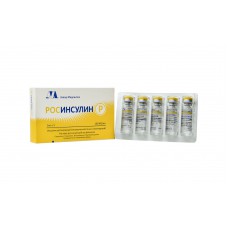Expiration date: 09/2026
Latin name: Rosinsuline P
The active ingredient: Insulin soluble [human genetic engineering]*(Insulin soluble [human biosynthetic]*)
Shelf life: 2 years
Storage conditions
List B. In the dark place at a temperature of 2-8 °C (do not freeze).
International name: Insulin soluble [human semisynthetic]
Dosage form: solution for injection
Pharmacological action:
The drug of short-acting insulin. After p/to the injections action occurs within 20-30 min, reaches its maximum after 1-3 hours and lasts, depending on the dose, 5-8 h Duration of action of the drug depends on the dose, method, site of injection and has significant individual characteristics.
Indications:
Diabetes mellitus type 1, diabetes mellitus type 2: stage of resistance to oral hypoglycaemic drugs, partial resistance to oral hypoglycemic drugs (combination therapy), diabetic ketoacidosis, and hyperosmolar coma ketoatsidoticheskaya, diabetes mellitus arising during pregnancy (with poor diet), for intermittent use in patients with diabetes mellitus on a background of infections accompanied by high temperature, with the upcoming surgery, trauma, childbirth, disorders of metabolism, before going for the treatment of prolonged insulin preparations.
Contraindications:
Hypersensitivity, hypoglycaemia.
Dosing regimen:
Dose and route of administration of the drug is determined individually in each case based on the content of blood glucose before meals and 1-2 hours after a meal, and depending on the degree of glycosuria and characteristics of the disease. The drug is injected p/to the in/m,/in for 15-30 minutes before meals. The most common method of introduction - n/a. diabetic ketoacidosis, diabetic coma, in the period of surgery - in/in and/m. In monotherapy, the frequency of administration is usually 3 times a day (if necessary - up to 5-6 times a day), site of injection each time change to prevent development of lipodystrophy (atrophy or hypertrophy of subcutaneous fat). Average daily dose is 30-40 UNITS, children - 8 UNITS, then the average daily dose of 0.5 - 1 U/kg or 30-40 IU 1-3 times daily, if necessary - 5-6 times a day. At a daily dose exceeding 0.6 U/kg insulin must be administered in the form of 2 or more injections in different areas of the body. May be combined with long-acting insulins. A solution of insulin recruited from the vial by piercing a sterile needle of the syringe rubber stopper, mashed after removing the aluminum cap with ethanol.
Side effects:
Allergic reactions (urticaria, angioedema fever, shortness of breath, decreased blood pressure), hypoglycaemia (paleness, increased sweating, perspiration, palpitations, tremor, hunger, excitement, anxiety, paresthesia in the mouth area, headache, drowsiness, insomnia, fear, depressive mood, irritability, unusual behavior, uncertainty movements, violations of speech and vision), hypoglycemic coma, hyperglycemia and diabetic acidosis (at low doses, skipping injections, poor diet, against fevers and infections): drowsiness, thirst, loss of appetite, redness of the face), impairment of consciousness (up to the development prekomatosnoe and coma), transient visual disturbances (usually at the beginning of therapy), immunological cross-reaction with human insulin, increased titer of antibodies antiinsulinovykh with subsequent growth of glycemia, redness, itching, and lipodystrophy (atrophy or hypertrophy of subcutaneous fat) at the injection site. At the beginning of treatment - swelling and a violation of refraction (of a temporary nature and disappear with continued treatment).
Overdose:
Symptoms: hypoglycemia (weakness, 'cold' sweat, pallor, palpitations, tremors, nervousness, hunger, paresthesias in the hands, feet, lips, tongue, headache), hypoglycemic coma, convulsions. Treatment: mild hypoglycemia, the patient can correct yourself, taking into sugar or easily digestible carbohydrate rich foods. P/to, in/m or/injected glucagon or/in hypertonic dextrose solution. With the development of hypoglycemic coma/jet injected 20-40 ml (100 ml) 40% dextrose solution as long as the patient does not come out of a coma.
Interaction:
Farmatsevticeski incompatible with solutions. LS. Enhance the hypoglycemic effect of sulfonamides (including oral hypoglycemic drugs, sulfonamides), MAO inhibitors (including furazolidone, procarbazine, selegiline), carbonic anhydrase inhibitors, ACE inhibitors, NSAIDs (including salicylates), anabolic steroids (including stanozolol, Oxandrolone, methandrostenolone), androgens, bromocriptine, tetracyclines, clofibrate, ketoconazole, mebendazole, theophylline, cyclophosphamide, fenfluramine, drugs Li+, pyridoxine, quinidine, quinine, chlorogenic, ethanol. Hypoglycemic effect weaken glucagon, somatropin, corticosteroids, oral contraceptives, estrogen, thiazide and loop diuretics, bmkk, thyroid hormones, heparin, sulfinpirazon, sympathomimetics, danazol, tricyclic antidepressants, clonidine, calcium channel blockers, diazoxide, morphine, marijuana, nicotine, phenytoin, epinephrine, H1-blockers-histamine receptors. Beta-blockers, reserpine, octreotide, pentamidine can both enhance, and weaken the hypoglycemic action of insulin.


